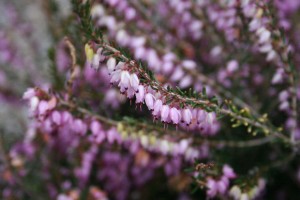Today I’ve started researching pH meters. One of the many things I have learned in the Master Gardener classes is the importance of testing soil pH, and making sure that I’m providing my plants with the pH they need. My dad used to have the old-fashioned test tube kits, and then he had one of the newer electronic gadgets with the probe and the meter on top. I think we threw it out when we cleaned out the house after he died; I don’t think any of my siblings took it. I’m actually surprised that he continued to test the garden soil in our little garden on Long Island. My dad built raised beds for the garden, the same as I did here at Seven Oaks, but he spent an awful lot of money buying Pro Mix and pouring bag after bag into the beds. He had wonderful compost and the beds were a beautiful fluffy mix of commercial potting soil and excellent compost. I think you could stick anything in that garden soil and get it to grow, like in the Narnia books when a piece of toffee falls out of the pocket and grows into a toffee-tree in Narnia. It was that good of a soil.
But what I have learned in my Master Gardener classes, among many things, is that soil pH matters. I take soil pH for granted because in the place where I learned to garden, my dad had already done the hard work and spent the money on the best quality soil he could buy and the best quality compost he could make.
Soil pH makes nutrients available to the plants. When the pH is in the proper range, the plants can absorb more nutrients. That makes them healthy and strong – and in turn, provides me and my family with better nutrition. Not only that, but in last week’s lawn care lecture, I learned that the massive amount of weeds we have here may just be an indication that the soil pH remains too low. The instructor said that certain weeds thrive in lower pH areas; once the pH returns to where lawns like it, around 6.5 – 6.8, the weeds don’t like it. Hmmm. Make my land inhospitable to weeds simply by adding lime to raise the pH? That sounds like a wonderful idea.
I don’t think I will ever be totally weed-free; weed seeds blow in from the cattle field around here, and there are many acres of wild, untamed woods where ‘anything grows.’ But if I can prevent blossom end rot on the tomatoes…if I can keep those awful weeds from choking out my flowers as they are threatening to do…all by adjusting the pH, it’s time to test the soil.
I’ve started looking into the various pH meters and I think I am going to get the electronic one with the probe. You just place it in the ground, leave it for a few minutes, and you get a reading. It also provides a ballpark estimate of the N-P-K (nitrogen, phosphorous and potassium, the three macro nutrients plants need and the numbers on the bags of fertilizer at the store) so I can get a good estimate of that, too.
Luster Leaf 1606 Rapitest Digital Soil pH Tester
I’ll start looking tomorrow at the big box stores after church services for my pH meter. In the meantime, though, I’m heading out today to start prepping the vegetable garden beds and we need to trim the phlox before it over runs the front walkway.






